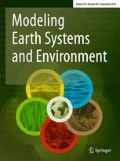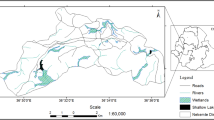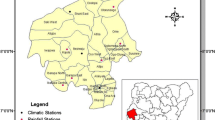Abstract
The purpose of the current study is to compare two kinds of allocation maps. In this investigation, the first map is taken from a supervised classification of the advanced spaceborne thermal emission and reflection radiometer imagery, and the other map is adopted from topo-climatic data assessment; the self-organizing map (SOM) and multi-layer perception (MLP). Topo-climatic data were analysed through artificial neural network (ANN) techniques as it has allowed not only to detect to distinct between low, moderate and high allocation zones. A new computational framework was developed in this research to compare results between two different methods including SOM and MLP. In this field, geographic information system (GIS) is applied due to the ability of GIS databases to integrate and work with information from heterogeneous and uncertain data into a geospatial context. The results show that the MLP was significantly close to current cultivation. Yet, it has provided better insights compared to the SOM in safe regions with regard to citrus allocation maps (CAMs). An accuracy assessment of 99.8% demonstrated the allocation of the proposed approach. Consequently, the comparison and differences of SOM and MLP algorithm of ANN method along with the topo-climatic factors could help policymakers and planners to improve the accuracy of CAMs.









Similar content being viewed by others
References
Adeloye A, Rustum R, Kariyama I (2012). Neural computing modeling of the reference crop evapotranspiration. Environ Model Softw 29:61–73
Aguado D, Montoya T, Borras L, Seco A, Ferrer J (2008) Using SOM and PCA for analysing and interpreting data from a P-removal SBR. Eng Appl Artif Intell 21:919–930
Alhoniemi E, Hollmén J, Simula O, Vesanto J (1999) Process monitoring and modeling using the self-organizing map. Integr Comput Aided Eng 6(1):3–14
Argent RM (2004) An overview of model integration for environmental applications—components, frameworks and semantics. Environ Model Softw 19:219–234
Birkmann B (2007) Risk and vulnerability indicators at different scales: applicability, usefulness and policy implications. Environ Hazards 7:20–31
Bishop C (1995). Neural networks for pattern recognition. Clarendon Press, Oxford
CDCGC (2004) Citrus and date crop germplasm Committee. USA. Citrus and Date Germplasm: Crop Vulnerability, Germplasm Activities, Germplasm Needs. Citrus and Date Crop Germplasm Committee, USA, pp 1–30
Chen N, Ribeiro B, Vieira A, Chen A (2013) Clustering and visualization of bankruptcy trajectory using self-organizing map. Expert Syst Appl 40:385–393
Cho SE (2009) Probabilistic stability analyses of slopes using the ANN-based response surface. Comput Geotech 36:787–797
Cho S, Han C, Han DH, Kim HI (2000) Web-based keystroke dynamics identity verification using neural network. J Organ Comput Electr Commer 10(4):295–307
Dogan E, Sengorur B, Koklu R (2009) Modeling biological oxygen demand of the Melen River in Turkey using an artificial neural network technique. J Environ Manage 90(2):1229–1235
ESRI (2011) ArcGIS desktop: release 10. Environmental Systems Research Institute, Redlands
Falamarzi Y, Palizdana N, Huang Y, Lee T (2014) Estimating evapotranspiration from temperature and wind speed data using artificial and wavelet neural networks (WNNs). Agric Water Manage 140:26–36
Forti A, Foresti GL (2006) Growing Hierarchical Tree SOM: an unsupervised neural network with dynamic topology. Neural Netw 19:1568–1580
Gencoglu MT, Cebeci M (2009) Investigation of pollution flashover on high voltage insulators using artificial neural network. Expert Syst Appl 36:7338–7345
Ghaseminezhad MH, Karami A (2011) A novel self-organizing map (SOM) neural network for discrete groups of data clustering. Appl Soft Comput 11:3771–3778
Gómez-Sanchis J, Martín-Guerrero JD, Soria-Olivas E, Martínez-Sober M, Magdalena-Benedito R, Blasco J (2012) Detecting rottenness caused by Penicillium genus fungi in citrus fruits using machine learning techniques. Expert Syst Appl 39:780–785
Gómez-Sanchis J, Blasco J, Soria-Olivas E, Lorente D, Escandell-Monteroa P, Martínez-Martínez JM, Martínez-Sober M, Aleixos N (2013) Hyperspectral LCTF-based system for classification of decay in mandarins caused by Penicillium digitatum and Penicillium italicum using the most relevant bands and non-linear classifiers. Postharvest Biol Technol 82:76–86
Hasni A, Sehli A, Draoui B, Bassou A, Amieur B (2012) Estimating global solar radiation using artificial neural network and climate data in the south-western region of Algeria. Energy Procedia 18:531–537
Haykin S (2009). Neural networks and learning machines. Prentice-Hall, Upper Saddle River
He B, Oki T, Sun FB, Komori D, Kanae S, Wang Y, Kim H, Yamazaki D (2011) Estimating monthly total nitrogen concentration in streams by using artificial neural network. J Environ Manage 92(1):172–177
Huo Z, Feng S, Kang S, Dai X (2012) Artificial neural network models for reference evapotranspiration in an arid area of northwest China. J Arid Environ 82:81–90
Jang H, Topal E (2013) Optimizing overbreak prediction based on geological parameters comparing multiple regression analysis and artificial neural network. Tunn Undergr Space Technol 38:161–169
Ji CY (2000). Land-use classification of remotely sensed data using Kohonen selforganizing feature map neural networks. Photogramm Eng Remote Sens 66:1451–1460
Jiang Y, Nan Z, Yang S (2013) Risk assessment of water quality using Monte Carlo simulation and artificial neural network method. J Environ Manage 122:130–136
Jin H, Shum WH, Leung KS, Wong ML (2004) Expanding self-organizing map for data visualization and cluster analysis. Inf Sci 163:157–173
Kadirgama K, Amirruddin AK, Bakar RA (2014) Estimation of solar radiation by artificial networks: east coast Malaysia. In: 2013 International Conference on Alternative Energy in Developing Countries and Emerging Economies, 52. Energy, Procedia, pp 383–388
Kangas J, Simula O (1995) Process monitoring and visualization using self organizing map. In: Bulsari AB (ed) Neural networks for chemical engineers, vol 14. Elsevier Science, Dordrecht
Kaul M, Hill RL, Walthall C (2005) Artificial neural networks for corn and soybean yield prediction. Agric Syst 85:1–18
Kawabata D, Bandibas J (2009) Landslide susceptibility mapping using geological data, a DEM from ASTER images and an Artificial Neural Network (ANN). Geomorphology 113:97–109
Khoshnevisan B, Rafiee S, Omid M, Mousazadeh H, Sefeedpari P (2013) Prognostication of environmental indices in potato production using artificial neural networks. J Cleaner Prod 52:402–409
Khoshnevisan B, Rafiee S, Omid M, Mousazadeh H, Rajaeifar MA (2014) Application of artificial neural networks for prediction of output energy and GHG emissions in potato production in Iran. Agric Syst 123:120–127
Kohonen T, Oja E, Simula O, Visa A, Kangas J (1996) Engineering applications of the self-organizing map. Proc IEEE 84(10):1358–1384
Kourgialas NN, Dokou Z, Karatzas GP (2015) Statistical analysis and ANN modeling for predicting hydrological extremes under climate change scenarios: the example of a small Mediterranean agro-watershed. J Environ Manage 154:86–101
Kumar J, Brooks B, Thornton P, Dietze M (2012) Sub-daily statistical downscaling of meteorological variables using neural networks. In: International Conference on Computational Science, ICCS 2012. Procedia Computer Science, 9, 887–896
Kurtulmus F, Lee WS, Vardar A (2014) Immature peach detection in colour images acquired in natural illumination conditions using statistical classifiers and neural network. Precis Agric 15:57–79
Landeras G, Ortiz-Barredo A, Lo´pez J (2008) Comparison of artificial neural network models and empirical and semi-empirical equations for daily reference evapotranspiration estimation in the Basque Country (Northern Spain). Agric Water Manag 95(5):553–565
Lee E, Seong C, Kim H, Park S, Kang M (2010) Predicting the impacts of climate change on nonpoint source pollutant loads from agricultural small watershed using artificial neural network. J Environ Sci 22:840–845
Li Q, Wang M, Gu W (2002) Computer vision based system for apple surface defect detection. Comput Electron Agric 36(23):215–223
Li X, Yang P, Ren S, Ren L, Li P, Du J (2010) Modelling of the canopy conductance of potted cherry trees based on an artificial neural network. Math Comput Model 51:1363–1367
Lou W, Ji Z, Sun K, Zhou J (2013) Application of remote sensing and GIS for assessing economic loss caused by frost damage to tea plantations. Precis Agric 14:606–620
Lucieer V, Hill NA, Barrett NS, Nichol S (2013). Do marine substrates ‘look’ and ‘sound’ the same? Supervised classification of multibeam acoustic data using autonomous underwater vehicle images. Estuar Coast Shelf Sci 117:94–106
Martí P, Gasque M, González-Altozano P (2013) An artificial neural network approach to the estimation of stem water potential from frequency domain reflectometry soil moisture measurements and meteorological data. Comput Electr Agric 91:75–86
Mekanik F, Imteaz MA, Gato-Trinidad S, Elmahdi A (2013) Multiple regression and artificial neural network for long-term rainfallforecasting using large scale climate modes. J Hydrol 503:11–21
Moshou D, Bravo C, West J, McCartney A, Ramon H (2004) Automatic detection of yellow rust in wheat using reflectance measurements and neural networks. Comput Electron Agric 44(3):173–188
Nekhay O, Arriaza M, Boerboom L (2009) Evaluation of soil erosion risk using analytic network process and GIS: a case study from Spanish mountain olive plantations. J Environ Manage 90:3091–3104
Nguwi YY, Cho SY (2010) Emergent self-organizing feature map for recognizing road sign images. Neural Comput Appl 19:601–615
Nourani V, Sayyah Fard M (2012) Sensitivit analysis of the artificial neural network outputs in simulation of the evaporation process at different climatologic regimes. Adv Eng Softw 47:127–146
Pan G, Pan J (2012) Research in crop land suitability analysis based on GIS. Comput Comput Technol Agric 365:314–325
Pan TY, Yang YT, Kuo HC, Tan YC, Lai JS, Chang TJ, Lee CS, Hsu KH (2013) Improvement of watershed flood forecasting by typhoon rainfall climate model with an ANN-based southwest monsoon rainfall enhancement. J Hydrol 506:90–100
Pijanowski BC, Tayyebi A, Doucette J, Pekin BK, Braun D, Plourde J (2014). A big data urban growth simulation at a national scale: configuring the GIS and neural network based land transformation model to run in a high performance computing (HPC) environment. Environ Model Softw 51:250–268
Santos NI, Said AL, James DE, Venkatesh NH (2012) Modeling solar still production using local weather data and artificial neural networks. Renew Energy 40:71–79
Sulkava M, Sepponen AM, Yli-Heikkilä M, Latukka A (2015) Clustering of the self-organizing map reveals profiles of farm profitability and upscaling weights. Neurocomputing 147:197–206
Tananaki C, Thrasyvoulou A, Giraudel JL, Montury M (2007) Determination of volatile characteristics of Greek and Turkish pine honey samples and their classification by using Kohonen self organizing maps. Food Chem 101(4):1687–1693
Tayyebi A, Pijanowski BC (2014) Modeling multiple land use changes using ANN, CART and MARS: comparing tradeoffs in goodness of fit and explanatory power of data mining tools. Int J Appl Earth Obs Geoinf 28:102–116
Vairavamoorthy K, Yan J, Galgale HM, Gorantiwar SD (2007) IRA-WDS: a GIS-based risk analysis tool for water distribution systems. Environ Model Softw 22:951–965
Yadav AK, Chandel SS (2014) Solar radiation prediction using artificial neural network techniques: a review. Renew Sustain Energy Rev 33:772–781
Yang Y, Tan W, Li T, Ruan D (2012) Consensus clustering based on constrained self-organizing map and improved Cop-K means ensemble in intelligent decision support systems. Knowl Based Syst 32:101–115
Zabihi H, Ahmad A, Vogeler I, Nor Said M, Golmohammadi M, Golein B, Nilashi M (2015). Land suitability procedure for sustainable citrus planning using the application of the analytical network process approach and GIS. Comput Electr Agric 117:114–126
Zhang H, Zhang Y, Lin H (2012) A comparison study of impervious surfaces estimation using optical and SAR remote sensing images. Int J Appl Earth Obs Geoinf 18:148–156
Acknowledgements
The authors would like to thank to Citrus and Subtropical Fruits research Center, Ramsar, Iran and the Department of Geoinformation in Universiti Teknologi Malaysia (UTM) to prepare opportunity and providing facilities for this investigation.
Author information
Authors and Affiliations
Corresponding author
Ethics declarations
Conflict of interest
The authors declare no competing financial interest. We have read and understood the policy on declaration of interests and declare that we have no competing interests; no support from any organization for the submitted work; no financial relationships with any organizations that might have an interest in the submitted work in the previous 3 years; no other relationships or activities that could appear to have influenced the submitted work.
Rights and permissions
About this article
Cite this article
Zabihi, H., Alizadeh, M., Vogeler, I. et al. Land allocation based on spatial analysis using artificial neural networks and GIS in Ramsar, Iran. Model. Earth Syst. Environ. 3, 1515–1527 (2017). https://doi.org/10.1007/s40808-017-0371-3
Received:
Accepted:
Published:
Issue Date:
DOI: https://doi.org/10.1007/s40808-017-0371-3




